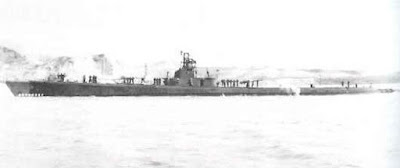"Lost at sea."
Sailors always get a little bit of the feels when they hear that phrase. The oceans are a large, beautiful, and terrifying place.
People and ships can, and do, just disappear without a trace, especially at war.
In time, some are found - and there is peace in that discovery.
They found the USS Albacore (SS-218).
NHHC’s Underwater Archaeology Branch (UAB) used information and imagery provided by Dr. Tamaki Ura, from the University of Tokyo, to confirm the identity of Albacore, which was lost at sea Nov. 7, 1944.
“As the final resting place for Sailors who gave their life in defense of our nation, we sincerely thank and congratulate Dr. Ura and his team for their efforts in locating the wreck of Albacore,” said NHHC Director Samuel J. Cox, U.S. Navy rear admiral (retired). “It is through their hard work and continued collaboration that we could confirm Albacore’s identity after being lost at sea for over 70 years.”
Japanese records originating from the Japan Center for Asian Historical Records (JACAR) covering the loss of an American submarine on Nov. 7, 1944, guided Dr. Ura’s missions. The location mentioned in the records matched a separate ongoing effort by UAB volunteers to establish the location of the shipwreck.
Dr. Ura’s team collected data using a Remotely Operated Vehicle to confirm the historical data. Strong currents, marine growth, and poor visibility on site made it challenging to fully document the wreck or obtain comprehensive images. However, several key features of a late 1944 Gato-class submarine were identified in the video.
Indications of documented modifications made to Albacore prior to her final patrol such as the presence of an SJ Radar dish and mast, a row of vent holes along the top of the superstructure, and the absence of steel plates along the upper edge of the fairwater allowed UAB to confirm the wreck site finding as Albacore.
The wreck of Albacore is a U.S. sunken military craft protected by U.S. law and under the jurisdiction of NHHC. While non-intrusive activities, such as remote sensing documentation, on U.S. Navy sunken military craft is allowed, any intrusive or potentially intrusive activities must be coordinated with NHHC and if appropriate, authorized through a relevant permitting program. Most importantly, the wreck represents the final resting place of Sailors that gave their life in defense of the nation and should be respected by all parties as a war grave.
Albacore was constructed by the Electric Boat Company in Groton, CT and commissioned on June 1, 1942. Before being lost in 1944, she conducted 11 war patrols and is credited with 10 confirmed enemy vessel sinkings, with possibly another three not yet confirmed. Albacore earned nine battle stars and four Presidential Unit Citations during her career. Six of the ten enemy sinkings were enemy combatant ships, ranking her as one of the most successful submarines against enemy combatants during World War II.


No comments:
Post a Comment